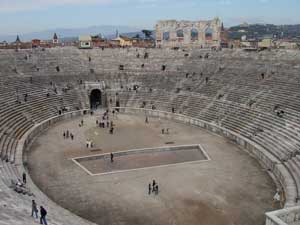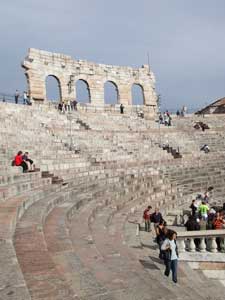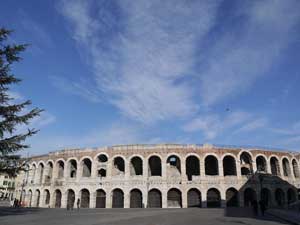Seeing the opera in Verona is one of Italy’s great travel experiences. Every summer the city’s Roman Arena is taken over by grandiose opera productions on an epic scale. Many music-loving travellers visit Verona just to attend the opera; the town’s charms are an attractive extra. If you are staying in or around Verona during the summer, it is well worth planning an evening at the opera to appreciate the music, the spectacle, and the experience of spectating at an event in this ancient Roman venue.
The Arena is situated in Piazza Brà, a large square that is the main entrance point to the historic heart of Verona. There are cafes and restaurants opposite, including handy Italian self-service restaurant Brek.
Planning: Tickets and accommodation
The opera season at the Arena generally runs from late July to the beginning of September. You can book tickets in advance using the official website (see links panel) or through various re-sellers. It’s possible to book a holiday in Verona through a travel agency with opera tickets included, but I’d recommend researching a DIY version to compare the prices.
In Verona, tickets can be bought at various outlets, including the official ticket office beside the Arena in Via Dietro Anfiteatro (to the left as you face the Arena in Piazza Brà), at branches of Unicredit bank and through some Verona hotels. You may be able to buy tickets on the day if you’d prefer to wait and check the weather forecast … but if this is the trip of a lifetime, it would be safer to purchase tickets in advance.
Seats vary greatly in price and comfort, ranging from chairs in rows in front of the stage to the bare stone steps of the upper levels of the Roman seating. A seating plan is available on the website to help you choose. The prime stage-front seats (poltronissime) are the most expensive, while tickets to sit on the un-numbered stone seating start at more affordable prices. For the best numbered seats you should really book in advance. In the un-numbered section, audiences arrive early to choose their spot.
Evening performances are long – especially if there are rain delays (see below) – so it is strongly advisable to book accommodation nearby and benefit from the peace of mind of knowing you only have a short walk back after the show. It is pretty much impossible to see a full performance and travel to another area – Lake Garda for example – afterwards by public transport. If you are coming from outside Verona, and don’t want to stay in town overnight, bring your own transport or pay for an organised coach trip. Several Lake Garda resorts – those along the southern and eastern shores – are served by special opera bus trips, and these will get you back to your resort at night.

If it rains
Refunds only apply if the performance is cancelled before it has started; if the opera gets called off part-way through, there is no compensation. If it starts to rain during a performance you’ll see the orchestra running for cover to protect their instruments. In the case of a short shower, the performance is likely to resume afterwards, so the audience will have to shelter under waterproofs and prepare for a long evening. Come prepared if the weather forecast is doubtful.
Other practicalities
Sun protection may be useful if you’re intending to queue or arrive early while the sun is still shining. In hot weather a fan can be useful. Consider applying insect repellent before dusk falls, and take warmer clothing in case temperatures drop. You’re not allowed to enter with food or drink; you can buy refreshments inside the Arena before the performance and during intervals. Spectators in the cheaper stone seating areas can hire cushions to sit on. Binoculars or opera glasses would also be a good idea.
On the official Arena website (below) you’ll find detailed information about refunds, bad-weather policies and many rules which the audience must follow (for example, no large bags, food or drink admitted; no photography during the show). Note that the rules also state: “Spectators are required to dress in an elegant manner, appropriate to a theatre venue.” Although these rules are not always heeded, or enforced – some audience-members complain about excessive flash photography ruining the atmosphere – it’s as well to read them through before you go.

Year-round opera and ballet
During the rest of the year the Arena can be visited as a tourist attraction. Opera, ballet and musical concerts can be enjoyed indoors at the Teatro Filarmonico; the programme is published on the Arena website.
Visiting the Arena
The Roman Arena is open to the public all year round, and is an important tourist sight with or without an opera performance included. It is the third-largest Roman amphitheatre in Italy. Dating to the 1st Century AD, the Arena was built from the characteristic local pink and white stone, and could perhaps have seated as many as 30,000 spectators at gladiatorial combats, mock naval battles and other such popular entertainments . The Arena is closed on Monday mornings. During the opera season, or when there are one-off concerts, the Arena closes by mid-afternoon, and the historical structure will be obscured by a stage and seating. Entrance is included with the Verona Card combined ticket. Between October and May there are special cheap admission tickets on the first Sunday of the month.
> See a selection of the best Verona hotels and B&Bs including some very close to the Arena
> Arena di Verona official website
Veneto destinations
- Veneto region
- Abano Terme
- Asolo
- Bassano del Grappa
- Brenta Canal
- Caorle
- Castelfranco Veneto
- Chioggia
- Cittadella
- Conegliano
- Cortina d’Ampezzo
- Lido di Jesolo
- Malcesine
- Marostica
- Monselice
- Montegrotto Terme
- Padua
- Rovigo
- Sottomarina
- Treviso
- Venetian Lagoon
- Venice
- Verona
- Vicenza
- Veneto art & architecture itinerary
- Veneto villas – Vicenza: La Rotonda & Villa Valmarana ai Nani
- Veneto villas – Villa Pisani & Villa Foscarini Rossi, Strà
- Venice Airport
- Treviso Airport
Veneto destinations
- Veneto region
- Abano Terme
- Asolo
- Bassano del Grappa
- Brenta Canal
- Caorle
- Castelfranco Veneto
- Chioggia
- Cittadella
- Concordia Sagittaria
- Conegliano
- Cortina d’Ampezzo
- Lido di Jesolo
- Malcesine
- Marostica
- Monselice
- Montegrotto Terme
- Padua
- Portogruaro
- Rovigo
- Sottomarina
- Treviso
- Venetian Lagoon
- Venice
- Verona
- Vicenza
- Veneto art & architecture itinerary
- Veneto villas – Vicenza: La Rotonda & Villa Valmarana ai Nani
- Veneto villas – Villa Pisani & Villa Foscarini Rossi, Strà
- Venice Airport
- Treviso Airport
